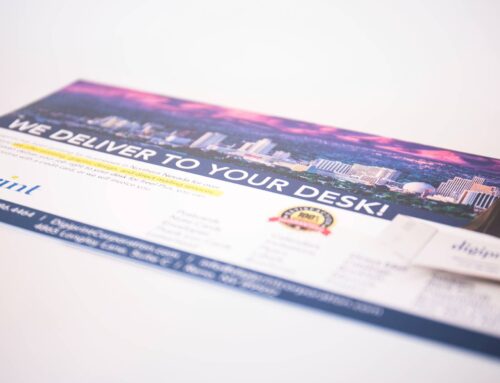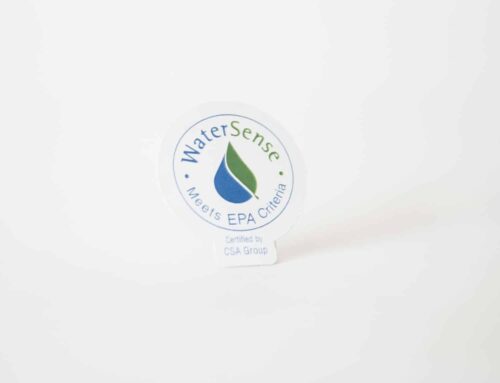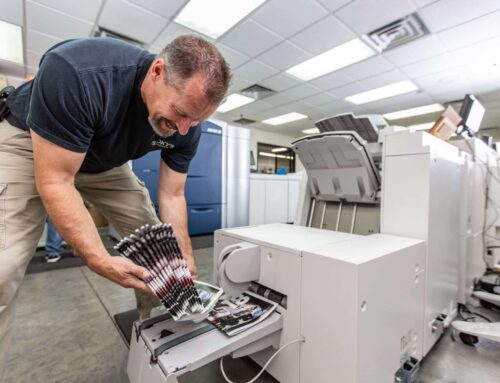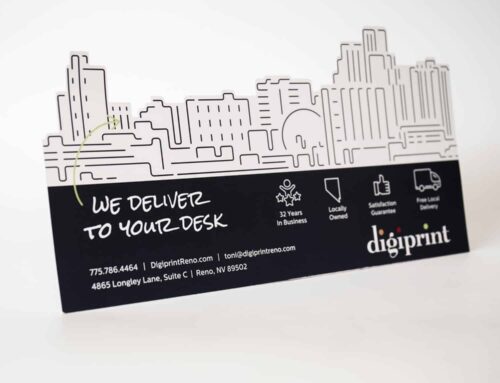Business cards — who knew a tiny piece of paper could mean so much?
It’s no wonder around 10 billion business cards are printed every year in the USA alone.
Fortunately, you don’t need to be a graphic designer or have the know-how of a Fortune 500 business to turn your business card ideas into reality. But the tricky part is knowing what to put on a business card.
Let us break down the ingredients of a great business card.

1. Your Name
What to put on a business card for a small business?
When you ask yourself this question, your name is probably the first thing that pops into your mind. Yes, your card will have your business name on it. But putting your name on it gives people a human connection to your brand, which is especially critical for small businesses.
Whether you real-estate, dental clinic, or tattoo shop business cards, your name should be the most prominent text on the card, clearly visible in a readable font size. But it shouldn’t overshadow other details. Place your title beneath your name in a marginally smaller font.
2. Your Company/Business Name
Giving someone a business card is a universal way of saying, “I want to do business with you,” which they’ll only be able to do if they know where you work. Therefore, it is a key element of any business card idea.
Instead of a company name, freelancers can use a brief description of themselves and/or their services. For example, “digital media and design services” is an excellent way of telling what people can hire you to do.
If you prefer something less formal, give yourself your dream job title like Marketing Maven, Digital Wizard, Code Guru, or Camera Queen. A fun title tells what you offer while opening the door for a conversation.
3. Your Contact Information
The next obvious question is – what information to put on a business card?
In today’s world, a phone number and email are non-negotiable elements of your business card. This is how your would-be customers will find you. If customers can’t find you, your company is no more real than the Loch Ness Monster. This vital information goes on all types of business cards, including dental appointment cards.
4. Your Addresses
“What to put on a business card for small business” often means different things to different businesses. For example, a freelance web designer may not need a physical address. However, brick-and-mortar businesses like dental clinics, real-estate agencies, and coffee ships will need a physical address.
Similarly, companies that perform professional services by mail should also include their mailing address, especially if it differs from their physical address. But if your company is more click than brick, a website URL and social media handles will be more helpful to your audience than a physical address.
For a brand whose target audience is tech-savvy, a custom QR code iswhat to put on the back of a business card. It is a sleek, free, and easy way to connect people with your business.
All your contact info will be available to your potential customers at the wave of their phone. Besides, most QR platforms allow you to customize the look of your QR to keep it in-brand.
5. Your Logo
Your business card idea is incomplete without your logo. If your logo is intricate or complex, consider adopting a more minimalist version for your business card, such as a silhouette or monochrome interpretation. This will prevent your logo from crowding your card and causing it to look cluttered.
If you are a freelancer, include a professional headshot on your business card. It can be a good substitute for a logo because it helps create a personal brand identity. It can also benefit any industry where building personal relationships are crucial to gain clients, such as real estate.
However, never make a logo or photo a part of the back of your business card ideas. These should be on the front as they are the focal point of your card design.
6. Tagline or Call to Action
Use a tagline or slogan to convey your brand’s offering, especially if the company’s name doesn’t provide a clear idea of what you’re selling. Remember, keep it short and sweet! Also, don’t use it for the back of your business card ideas. The call to action needs to be front and center.
If the name says it all, a call to action is a powerful sentiment that establishes a brand’s identity while encouraging people to connect with you. Reminding someone to “take the first step” or “change their life for the better,” might be the nudge that turns a passing conversation into a paying customer.
7. Whitespace
Balancing content and space is one of the hardest parts of designing a business card. Nobody likes a busybody, so trying to fit everything and the kitchen sink onto that tiny piece of paper can turn off future customers. Using whitespace is soothing to the eye and keeps readers from feeling overwhelmed by tons of information getting crammed onto a card.
There may be many great things people should know about your brand. But, you have very little space to tell them. As you go through the design process, consider how each element contributes to your sales funnel and customer’s journey.
And if you are not sure what to put on the back of a business card or its front, use the white space to your advantage. Remember, if something doesn’t play a role in amplifying your brand, it doesn’t need to be on the card.
8. Color
Whether you use business cards in Reno or anywhere else, a colored card will usually last 10-times longer than the standard white card. And because minimalism and whitespace are popular and effective techniques for business cards, go easy on the bright colors.
Use it to emphasize important words, break up blocks of text, or draw the eye to unique elements of your business card, such as your logo. If applicable, only use colors that are in-brand with your company. Even if you aren’t bound by brand identity, color selection is critical because color psychology can directly impact our opinions and decision-making.
9. Typography
In learning how to design a business card, remember that polished lettering significantly enhances its appearance. The right font pairings can simultaneously fit in more text and help the brain digest information. If you take away one thing from this article, let it be this: never settle for Times New Roman on your business card.
The art of arranging and displaying written language, a.k.a typography, is a complex and renowned area of study that people can spend years pursuing. Fortunately, though, there are lots of tools that can help anyone improve their font know-how. Fontjoy is a free site that lets you generate font pairings. You can also create your own typography schemes using widely-available fonts.
This site gives you the tools to explore typography, but if you want to learn more about the theory and best practices, check out this article on Career Foundry.
10. Should I use a business card template?
When exploring how to design a business card, it’s crucial to consider the numerous elements involved. However, with so many free options, it can be very tempting to forego all those decisions for the ease of plugging your information into a preformatted template. As enticing as it may be, it’s not a good idea.
It’s unlikely that a template will offer all the elements you want to include and capture your brand’s unique style. Besides, imagine going to a networking event and swapping cards with someone who clearly used the same online template as you.
Instead of relying on a template, you should look to them for design inspiration. Browse examples online (and any competitors’ business cards, if you can get a hold of them) and look for elements or designs that complement your brand. Take note of anything that you particularly like or particularly dislike. If something inspires you, run with it.
Conclusion
Of course, the easiest way to know what information to put on a business card is to call the experts (that’s us). Our mission is to create professional and effective business cards for new businesses, big businesses, and small business owners.
Our team of printing experts, including our in-house graphic designers, is here to assist you with all your design and print needs, including logo design. Should you need to design and print new business cards in Reno or Sparks, don’t forget to give us a call.
Ready for a quote? Let’s get it!





